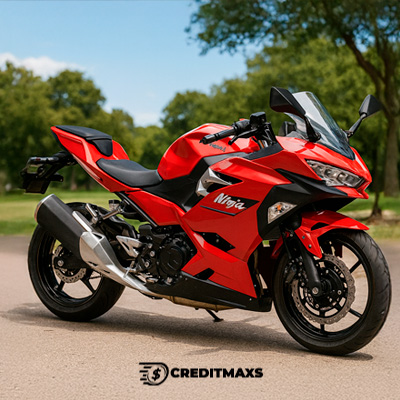Understand the Real Kawasaki Ninja 400 Cost in 2025
Discover how the Kawasaki Ninja 400 cost balances price, performance, and everyday practicality, making it a true benchmark for entry-level sportbikes.
Known for its aggressive styling, impressive handling, and dependable performance, the Ninja 400 is more than just an affordable ride—it is a motorcycle that adapts to different lifestyles.
In 2025, it continues to represent one of the smartest purchases for U.S. riders who want a reliable and exciting motorcycle without overspending.
Step into the world of affordable supersport performance with the Kawasaki Ninja 400 cost, one of the most competitive motorcycles in the U.S. market.
Discover motorcycle loans for fair credit, compare lenders, explore options and learn how to secure financing while improving your credit.
Get to Know Why the Kawasaki Ninja 400 Cost Continues to Impress Riders 🏍️

In 2025, the Kawasaki Ninja 400 cost starts at around $5,699 and tops out near $6,299, depending on colors and special editions. This makes it one of the best-value motorcycles in its category.
At this cost, buyers receive a 399cc liquid-cooled parallel-twin engine producing about 47 horsepower, enough for daily commutes and highway runs alike.
The Ninja 400 is known for its balance: it is light enough to inspire confidence in beginners but powerful enough to keep experienced riders entertained.
Its approachable ergonomics and predictable handling allow it to serve as both a first bike and a long-term companion.
Discover how to secure motorcycle loan approval in 2025 with better rates!
Compare Ninja 400 vs. Market Alternatives ⚖️
When evaluating the Kawasaki Ninja 400 cost, it is important to see how it compares to its closest competitors in the 2025 motorcycle landscape.
| Motorcycle | Price Range | Pros |
| Ninja 400 | $5,699–$6,299 | Balanced, reliable, stylish |
| Yamaha R3 | $5,499 | High fuel economy, lightweight |
| KTM RC 390 | $5,899 | Sporty handling, premium feel |
| Honda CBR500R | $7,299 | More power, highway comfort |
This table highlights how the Ninja 400 finds the middle ground—delivering power close to the Honda CBR500R but at a far lower cost, while outperforming the Yamaha R3 in stability and overall usability.
See Features That Add Value to the Ninja 400 🔧
Part of what makes the Kawasaki Ninja 400 cost appealing is the technology and design built into the motorcycle. For 2025, notable features include:
- Lightweight trellis frame designed for rigidity and agility.
- Dual-channel ABS for secure braking under pressure.
- Slipper clutch reducing wheel hop during aggressive downshifts.
- Comfortable 30.9-inch seat height suitable for most riders.
- Modern LCD instrumentation with clear rider information.
- Sportbike styling that mimics larger models like the ZX-6R.
These features ensure that the Ninja 400 feels premium without demanding premium prices, giving new riders confidence and experienced riders satisfaction.
Ready to compare lenders? Find out which motorcycle loan companies deliver the lowest rates for U.S. riders.
Understanding Ownership Costs of the Kawasaki Ninja 400 💵
The Kawasaki Ninja 400 cost goes beyond the initial purchase price. Riders in the U.S. also appreciate that ongoing expenses remain affordable. Here’s an overview of typical ownership costs:
- Fuel: Around 49 mpg, making it one of the most economical sportbikes in its class.
- Insurance: Averages between $400 and $600 annually, depending on age, state, and rider profile.
- Maintenance: Yearly upkeep ranges from $200 to $350, covering oil changes, inspections, and chain adjustments.
- Tires: Sets cost $250–$350, with lifespan varying based on riding habits.
Compared to larger displacement bikes, the Ninja 400 maintains one of the lowest total ownership costs in the supersport category.
Read How the Kawasaki Ninja 400 Fits Different Types of Riders 🏆
The Kawasaki Ninja 400 cost attracts a wide variety of riders because of its adaptability. Beginners value its forgiving nature and low seat height, while intermediate riders love its balance of power and agility.
Even experienced riders keep it as a second bike for city commuting or twisty canyon rides where light handling shines.
For riders considering stepping into larger Kawasaki models like the Ninja 650 or ZX-6R, the 400 provides a perfect starting point.
It is an entryway into Kawasaki’s broader sportbike family, making it part of a rider’s long-term journey.
Why the Kawasaki Ninja 400 Reflects More Than Numbers 🌟
Beyond specifications, the Kawasaki Ninja 400 cost reflects the value of lifestyle. Its styling allows riders to feel part of the supersport world, even at an entry-level price point.
It delivers emotional satisfaction by looking and feeling like its bigger Ninja siblings while remaining affordable and approachable.
This combination of emotional and financial return explains why the Ninja 400 is consistently one of the most recommended motorcycles for riders entering the market.
Ride Forward With the Kawasaki Ninja 400 in 2025 🌠
The Kawasaki Ninja 400 cost in 2025 solidifies its reputation as a smart choice in the entry-level supersport category.
With accessible pricing, advanced features, and low operating costs, it brings together everything a rider could want in a beginner-to-intermediate motorcycle.
For those in the U.S. seeking a bike that blends excitement with responsibility, the Ninja 400 is a proven favorite.
FAQ ❓
- What is the average 2025 Kawasaki Ninja 400 cost?
- Prices range from $5,699 to $6,299 depending on trim and edition.
- Is the Ninja 400 suitable for long rides?
- Yes, thanks to its comfortable ergonomics and smooth engine, it performs well for commuting and weekend trips.
- How does the Kawasaki Ninja 400 differ from the Yamaha R3?
- It delivers more horsepower and highway stability while keeping the cost competitive.
- What type of fuel economy can riders expect?
- The Ninja 400 achieves about 49 mpg, making it efficient for daily use.
- Why is the Kawasaki Ninja 400 cost considered a strong value?
- Because it combines affordability, advanced features, and long-term reliability unmatched in its class.
